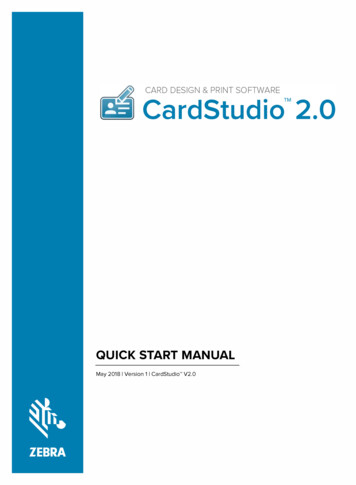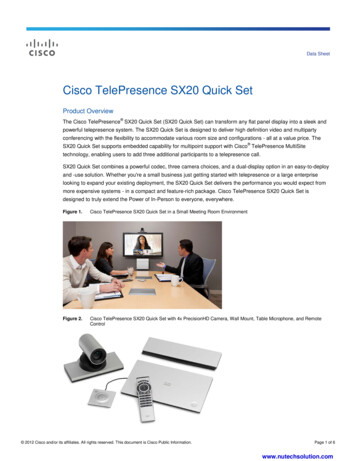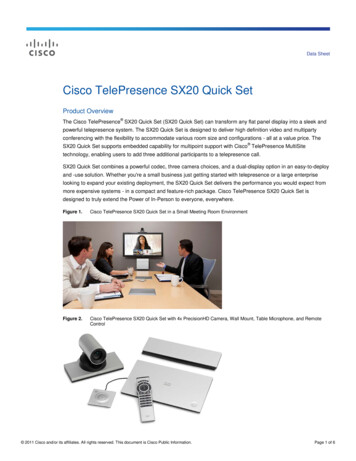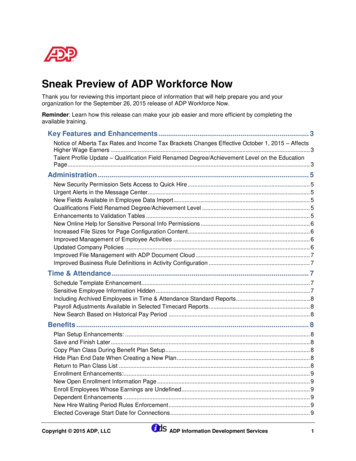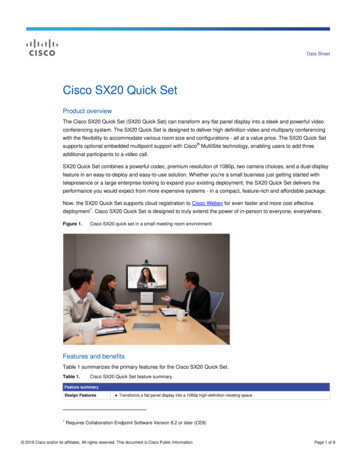
Transcription
A Quick Guide toMicroservice ArchitectureWhy this emerging trend is the future of software development
Why Choose a MicroserviceArchitecture?As the approach to software development evolves, theindustry as a whole and the technical leaders and engineers in the industry constantly look for areas thatcould benefit from continuous improvement. How do we get solutions to customers faster? How do we make changes quicker? How do we reduce the risk of regression defectsduring a release? How do we isolate performance issues?To understand microservice architecture, we shouldcompare it to the monolithic approach - a monolithicapplication that is typically built as a single unit.Enterprise Applications in general have the followingcomponents:1. Presentation layer (client side UI) with HTML pages,JavaScript.2. Business logic/server side layer – handles applicationlogic, handle request/responses to presentation layer, and DB calls.3. DatabaseThere is an emerging trend in the industry that servesto answer these very questions and more. It’s called aMicroservices Architecture.Briefly, the microservice architecture is a way of designing software apps as a suite of independent deployableservices that can scale and grow as needed.Most large scale web sites including Netflix,Amazon and eBay have evolved from a monolithic architecture to a microservicesarchitecture.These applications are defined in a Waterfall or Agileapproach, and developed by many or few engineers.An e-commerce application may have an architecturelike the one represented in the diagram below:
These applications are developed in a Waterfall or Agileapproach, by many or a few engineers. An e-commerceapplication may have an architecture like the one represented in the diagram.Benefits of a monolithic architecture Easy to test with automated test scripts using toolslike Selenium. Easy to deploy in the early stages of a project. You can scale the application by running multiplecopies behind a load balancer. The modular approach allows for code clarity andless abstraction. By keeping an existing architecture, you don’t havethe cost of redesign and re-architecturing.These factors apply well in early stages of application.The drawbacksThe system may be architected with modularity in mind,but code is stored in a single code base When it comesto packaging and deploying, you create one or a fewhuge executables. This deployment of large files existseven with minor changes. Although there are benefits,the downfalls have led to this newer microservice architecture.As successful applications grow over me, become complex and eventually bloat into muli-million lines ofcode, any change to the application or any bug fixeswill become increasingly difficult, time consuming, andrisky. Once an application grows and becomes large,the monolithic approach is likely to run into significantproblems: Complex code base – Typically development slowsdown as the code base grows in size and complexity,with several developers working on the application.This tends to have a big impact on the quality of theapplication.
Complex monolithic apps become an obstacle forcontinuous deployment. In today’s “get new featuresout quickly” approach, frequent code deploymentsare the norm. This is very difficult with a complexmonolithic app since the entire app has to be deployed even for a small change. Also to maintainquality, extensive testing is needed. This makes continuous deployment next to impossible. Monolithic apps can be difficult to scale. For example, some modules might be CPU-intensive and somemight need more memory, say for caching. As all themodules are deployed together, there can be compromises on the choice of hardware and the cost ofthe hardware. As applications become large and complex we canrun into stability issues. For example, a memory leakin a module can potentially bring down the wholeapplication. Monolithic apps make it extremely difficult to adoptnew technologies/frameworks. It would be extremely expensive (in both time and cost) to rewrite theentire application to use the newer framework, evenif that framework is considerably better. As a result,there is a huge barrier to adopting new technologies.You are stuck with whatever technology choices youmade at the start of the project.“A Monolithic architecture only makes sense forsimple, lightweight applications.”Chris Richardson, software architect
Evolution out of Monolithic ApplicationDevelopmentThe Road leads to MicroservicesWith the advent of service-oriented architectures (SOA)and web services in the cloud, the industry began tosteer towards what is now Microservices. But this initial SOA methodology had flaws as well and didn’t takehold in the way the industry prognosticators predicted.The SOA approach was a step in the right directionand paved the way for microservices. There is anothermajor factor that contributed to the evolution into thisnewer framework – that is the advent of cloud computing which allows for compute servers and containers tobe fired up quickly, on demand, and then turned downwhen not needed.The notion that you could architect away from largesingle code bases was solved, but the Enterprise ServiceBus (ESB) didn’t really solve the performance issues.Moreover, firms that adopted SOA often needed tobuy-in with a vendor for the ESB services.Firms would typically buy a large vendor-specificsolution , and it would be cost prohibitive to architectout of that solution. Great for the vendors, not so greatfor the engineering teams.In addition, the SOA environment itself required newskill sets to manage the environment and didn’t scalewell horizontally to handle performance issues. And itcertainly didn’t scale on demand.Both virtual machines in the cloud and computeservices, including Azure Functions and AWS Lambda,provided the infrastructure needed upon which thesemicroservices can thrive.Microservices in detailInstead of building a single huge, complex app, we cansplit it into a suite of services which are independently deployable and scalable. A service then implementsspecific and distinct functionality and has firmboundaries. Each service can have its own architectureand handle business logic and adapters to implementthe desired features. A service can publish APIs to beconsumed by other services.Microservices can publish updates and subscribe to updates as necessary.
The Microservices Architecture pattern corresponds tothe Y-axis scaling of Scale Cube, which is a 3D model ofscalability from the book The Art of Scalability, whichwas written by industry experts and application architects Martin L. Abbott and Michael T. Fisher.Y-axis scaling decomposes the application into Microservices, providing a higher level of scalability by splitting workloads into different functional components. Atruntime, X-axis scaling runs multiple instances of eachservice behind a load balancer for throughput and availability. Some applications might also use Z-axis scalingto partition the services.Why is microservices an emerging trend?Microservices exists because of the need to deploychanges quickly, reliably, on an infrastructure with thelowest cost. It is an answer to the competitive demandsfor new features and better performance from usersand businesses alike.The two readily known scaling dimensions are X-axisscaling, which consists of running multiple identicalcopies of the application behind a load balancer, andZ-axis scaling (or data partitioning), where an attributeof the request (for example, the primary key of a row oridentity of a customer) is used to route the request to aparticular server.
A microservice architecture contains thefollowing: The services are easy to deploy The services are organized around functional capabilities The services can be implemented with different languages, database, and hardware Services are independently deployable and fully encapsulated Lends itself to continuous delivery Enhancements and fixes can be isolated to just theservice that requires the modification, thus reducingregression risk.Some of the benefits are naturally inherent in the characteristics, however other advantages to this architecture include: Smaller individual code bases don’t slow down IDE’sthe way large monolithic code bases can. Programmers feel more productive with snappier responsiveness on their IDE’s You can differentiate the responsibilities of your devteam around the functional services and changes canbe deployed independently Services can be scaled easier and independently withcloning and partitioning for a single service if necessary – maybe to handle peak loads Memory leaks or defects will less likely disable theentire system, but rather be isolated to the service inquestion Because the services are small in nature, it is easierto adopt new technologies and languages becauseyou don’t need to rip and replace a large code base.
Microservices Architecture DrawbacksAs with any architecture, there are drawbacks to thisapproach.Drawbacks include the various components of theseservices and the management of the volume and dependencies. It can be tricky to get your arms aroundthem and architect it effectively. Some of your effortmust be in inter-process communication and ensuringperformance bottlenecks do not occur.Additionally, testing and building test scripts can bechallenging – especially at the unit test level. Decidingwhat and when to implement a microservicearchitecture can be a challenge. Typically, a new application may not have the volume nor complexities thatwarrant it.However, waiting until later won’t work either as developers can’t retrofit a monolithic app into a microservices architecture very easily.“Microservices are the first post DevOpsrevolution architecture.Neal Ford, Application ArchitectMet maximol uptaqui duciis dolupta temperovid magnimusda ducia sus sum sequi alibus explaborepe occabora qui conserum raecto quae ex elendit, omnissi doluptaectur adi dolo et quatem ipsusdam volupta quisitatequi ate debitas dit rersped moditae voluptatur?La vendeni aturior sit vent veri rerem quibus cus, sinimus, acerestin nonsequam, simus nem apictem autfugiae. Nequam inim sequae niet a in re re, non porporupta nit, andit eum fugit laborum dolo tem. Nemque es a dollabo. Cumque vollit laut qui nihillentis autvit reiusci dis duscit, ommoles simpore omniste mquatate pero eossi ut re quis se cus, int verfereritas sedisipsus, ipsus dolupicid que ommolor porepudae nis voloriberum hita volupta pos exerit lab ilit fuga. Nam raeomnient voluptatat quam, sus, simpor sus.Odigenis excepro vition pa aut ex ex exernat et mincimporeictur?Anti beribus evellic itinulpa distio quist ditaeri bercium,quisti asit libusdaestio conet et ea di andi omnihicipietetum eaqui qui omnis simus plant.Genihil liquiam, consequi rerupta errumenis moditelaborporem quatemporit atio. Cium etuscidunt estoeost escia nihil imi, nobisi occae. Quisquo delisquatesenesti sam quossi nonsedit, este nimos restia nonecusam qui rem quae pa non remporro quis dolorae nonet ommostis simagname vent et et acil enim faccaborrum quod qui ipsandam quam quia volutet volorum aconsend erciasinctem evellupta dolorup tatiatio. Namaria di restibu sciati aut faccabo. Ut evendio inusae.Nam consequi tenimi, quia nonestium aut reped magni
Menlo Technologies Approach toMicroservice ArchitectureAt Menlo Technologies, we typically wouldn’t recommend 100% microservices any more than we wouldsupport a 100% Agile approach. In order to achieve thebenefits of microservices and not experience the drawbacks, we support a hybrid approach. Let’s discuss thisbriefly by way of an example.Let’s assume you are asked to build a new mobile andweb app that has registration and location services.The location services may include GPS and mapping aswell as multiple reads and writes from thousands ormillions of users.Let’s also assume that the registration process is isolated and occurs once for a user with minimal updates.With this scenario, we would build the registration witha single code base but expose API’s to support mobileand web registration.However, for the location services, we would analyzeand divide every feature into its tiniest components andmicroservices. We would categorize the services andlog performance data continuously in order to allowfor automatic scaling depending on volume and performance. In this manner you have isolated themicroservices into the features that really need it.If your application could benefit from Microservices,now is the time to architect it into your environment.Start small and grow as you gain knowledge. If thehistory of software development evolution is any indicator, you can bet that this architecture will morph andimprove over time. You’ll need to get on the road firstthough in order to take advantage and continuouslyimprove.
There you have it. A brief overview of Microservice Architecture.Stay tuned for more web architecture resources fromMenlo Technologies as we explore more examples and discuss API managementand inter-process communication for a Microservice Architecture.Menlo Technologieswww.menlo-technologies.comCONTACT US
Microservices Architecture. Briefly, the microservice architecture is a way of design-ing software apps as a suite of independent deployable services that can scale and grow as needed. Most large scale web sites including Netflix, Amazon and eBay have evolved from a mono-lithic architecture to a microservices architecture.

